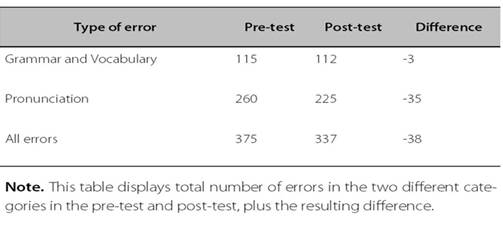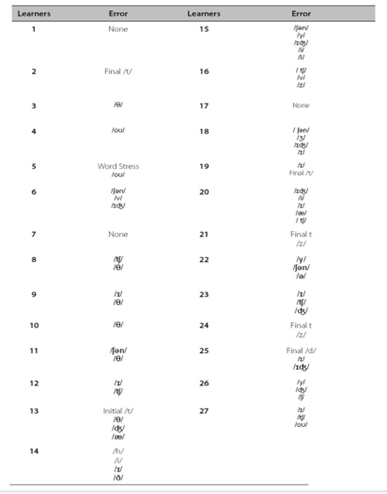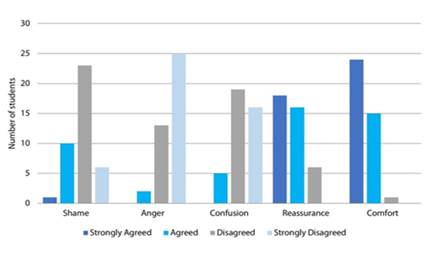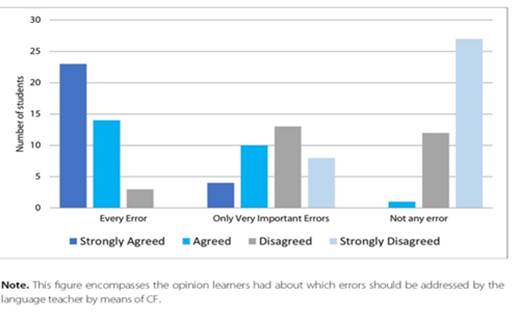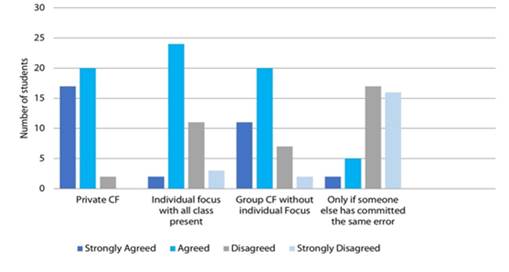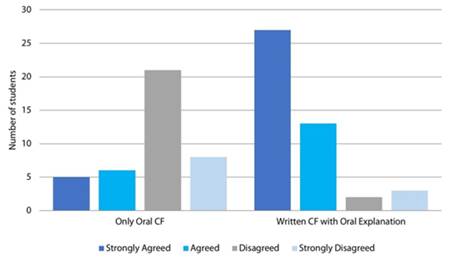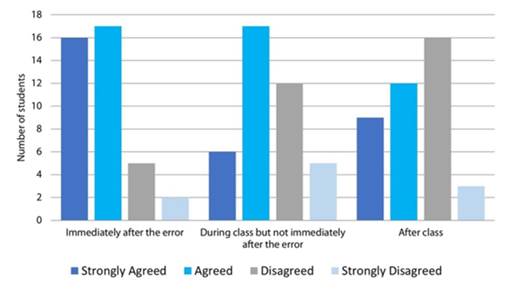INTRODUCTION
A thoughtful language teacher should always be attentive of the environment and receptive of every effect their own actions have on helping learners achieve their language learning goals. Questions such as Am I doing what I should be doing to foster students' learning and acquisition? Which are the best practices a language teacher can undertake to encourage students' intake, and consequently output? How should the different language related instances be addressed by the teacher in the classroom so that they become effective language learning experiences? How to take the greatest advantage from the learner-teacher interactions? are some that usually wander around the mind of these committed teachers. Even though Krashen's theories and hypotheses, where correction is barely welcomed, have provided enormous advances in the Second Language Acquisition (SLA) field, there are scholars who support the vital role of form-focused instruction in language classes (in the form of corrective feedback (CF) more specifically for the present research) - being Dr. Roy Lyster (see Lyster & Ranta, 1997; Lyster, 1998; Lee & Lyster, 2023) one of the most important.
With a new era of digital communications, a very varied sort of opportunities to teach and learn languages have blossomed. The global pandemic caused by Covid-19 that arrived at Costa Rica in the early 2020 created the necessity of taking sanitary measurements such as social distancing and wearing protection equipment (e.g. masks, face shields, gloves, etc). This health situation also affected education throughout the world. In the case of the university where this study was conducted, Universidad de Costa Rica, face-to-face classes were suspended since early March 2020 and a virtual modality was then adopted. Consequently, the teacher-student interactions migrated to online instances, and classes were then taught through virtual conferencing applications such as Zoom. Furthermore, the usual classroom interaction in speaking classes where the teacher and learners were present in the same place at the same time, and where CF was provided in-person in the same session was challenged and then it had to be rethought. Thus, with the apparition of remote, sometimes asynchronous learning, an asynchronous model that allowed providing insights on learners' oral productions was created. Asynchronous corrective feedback was chosen because virtual sessions are usually shorter than presence classes, and this leaves less room for teacher's interventions.
Corrective Feedback: Synchronous and Asynchronous
Corrective Feedback: is it more than just the responses a teacher provides towards/based on learners' production? Which are its purposes? Ellis, Loewen and Erlam (2006) stated that
…corrective feedback takes the form of responses to learner utterances (from the teacher) that contain an error. The responses can consist of (a) an indication that an error has been committed, (b) provision of the correct target language form, or (c) metalinguistic information about the nature of the error, or any combination of these. (p. 340)
Richards and Schmidt (2002) considered feedback as ''any information that provides information on the result of behavior.'' (p. 199). Also, they stated that ''In teaching, feedback refers to comments or other information that learners receive concerning their success on learning tasks or tests, either from the teacher or other persons.'' (p.199). Error correction -the old term for corrective feedback- encompasses all the ''strategies used by a teacher or more advanced learner to correct errors in a learner's speech. It may be direct (teacher supplies the correct form) or indirect (the teacher points out the problem and asks the learner to correct it if possible)'' (Richards & Schmidt, 2002, p.185). In this regard, the present study focused on teacher's responses towards learners' deviant forms of TL, and their effects on language acquisition visible in self-repair and uptake (terms that will be explained in coming paragraphs).
Starting from the principle that CF should always be used in language classes, that is, a focus on form from behalf the teacher, an important question arises: Which timing for feedback proves to be more effective for fostering language acquisition: Synchronous or asynchronous? Some scholars support the immediate (synchronous) addressing of students' deviant utterances (see Sheen & Ellis, 2001, Doughty, 2001, Dihoff, Brosvic, Epstein & Cook, 2004, Li et al., 2016). Doughty (2001, as cited in 12) assured that feedback should be provided on-line or immediately, in what he has called ''a window of opportunity'' (p. 596), (i.e., at a time that the learner is cognitively primed to attend to the correction). Among their arguments to prefer on-line over offline corrective feedback, they point that the most appropriate moment to address students' errors is at the exact moment when they are produced. A position that did not seem senseless to the present researcher.
Opposingly, other authors conceive delayed feedback to be the best choice when addressing learners' utterances containing errors (see Harmer,1983, Bartram and Walt,1991, Hedge, 2000, Vinagre & Muñoz, 2011, Bower, 2011, Hosseini, 2012, Samburskiy & Quah, 2014, Mousavi & Gorjian, 2018, Shabani & Safari, 2016) arguing, among other reasons, that immediate feedback would be a vane interruption of students' communicative activities just for the sake of focusing on mistakes, and thus, putting exaggerated emphasis on accuracy. Several authors (Quinn, 2014 & Dabaghi, 2006) believe that the timing when providing CF (synchronously or asynchronously) does not affect the acquisition of a second language (L2). They posit that there are not significant differences for language learners whether CF is provided immediately or in a delayed time. Lyster (1998) considers that the type of error committed by the language learner has a greater impact on the effectiveness of provided CF than the timing of teacher's interventions.
Finally, after reviewing related literature not a single study that analyzed the effects of asynchronous CF on the oral productions of English as a Foreign Language (EFL) learners in online environments following the model used in the present study was found in Costa Rica or abroad.
Learners' Errors in EFL Learning
''Errors are part of learning - mistaken hypotheses and wrong connections are normal.'' (Fanselow, 1977, p. 591)
Taking as a starting point that we all agree with Fanselow and consider errors made by language learners as intrinsic to language learning and acquisition processes, the next step would be to identify the best ways in which these errors should be treated by language teachers, if treated at all. However, the idea of conceiving errors as something intrinsic to learning and necessary in the development of one's skills has been rejected by many people throughout the years.
According to MacDonald et al. (2013), ''in the field of FLTL (Foreign Language Teaching and Learning), errors formed the basis of the teaching methodologies in the three decades from 1950 to 1980, where the focus was mainly on the product of language learning and the avoidance of any structures that were deviant in form from the standard target language'' (p.37). Nowadays, and with the evolution of the Communicative Approach and communications through technology around the world, a greater emphasis on the process has been put, thus, the treatment of deviant forms is now seen not as transcendental as it used to be, SLA specialists have turned their heads to a focus on meaning rather than a simple focus on form. Around 50 years ago, Fanselow (1977) considered that language teachers inclined to treating errors in meaning more than grammatical errors themselves. This might be considered evidence of the mindset change teachers were going through. This movement could probably have a certain relationship with Krashen's Comprehensive Input Hypothesis first published in 1977, just like Fanselow's work. Hence, in other words, teachers somehow started to ''oversee'' errors when they did not affect the ''sharing'' of the intended message.
Nevertheless, and based on the nature of the present study, the necessity of categorizing errors so that they can be identified and treated correctly by language teachers became a front-center endeavor. Almost four decades ago, Touchie (1986) proposed a set of errors categories: (a) phonological error: as when learners have difficulty in the distinction between phonemes (e.g. producing /p/ when /b/ should be produced and vice versa), (b) morphological error: errors such as womans, sheeps, and furnitures, (c) lexical error: inappropriate direct translation from the learner's native language or the use of wrong lexical items in the second language (e.g. home vs house), and (d) syntactic errors: word order, subject-verb agreement, and the such. Even when varied and, perhaps, more complete classifications of errors were proposed by other authors (e.g. MacDonald et al., 2013), the core categories for errors tabulation and analysis for the present study were limited to grammar, vocabulary and pronunciation, with the purpose of having a narrower list of items for learners to have a better understanding of what was signaled by the teacher.
Central to the field of SLA and core to the present study were the reactions and actions language teachers have towards errors students make, that is CF. In relation to this idea, Lyster and Ranta (1997) pro- vided a sequence for learner's error treatment. Their sequence begins with a learner's error that is later followed by teacher's CF or simply topic continuation. This CF provided by the teacher can be proceeded by uptake from the learner or not. When there is uptake, the original erroneous utterance is either repaired or continues to need repair. In the case there is still a need for repair, CF can be provided again by the teacher, if no feedback is provided, there is topic continuation. This means there is repair, which can be followed by some repair-related reinforcement provided by the teacher. Following this reinforcement there is topic continuation. As it is possible to notice from the sequence, chances are that still if the error is timely treated by the teacher, the student could not be capable of reaching an error-free construction of the TL feature treated, because even when there were responses from the learner towards teacher's interventions, these responses might need more treatment yet. The next section provides an overview of this process of treatment and responses between the teacher and the learner.
Uptake and self-repair
Core principles to SLA are the concepts of input, intake and uptake. The last being ''the responses learners give to feedback'' (Lyster & Ranta, 1997, p. 37). Even though these three processes are crucial in the acquisition of an L2, for the sake and nature of the present research, the emphasis was put on leaner's uptake visible after corrective feedback is provided. Lyster and Ranta (1997) offer a more detailed definition for uptake as ''a student's utterance which immediately follows the teacher's feedback, and which constitutes a reaction in some way to the teacher's intention to draw attention to some aspect of the student's initial utterance'' (p. 19). Let us point out here that their responses might still be completely or partially erroneous.
Repair, on the other hand, is defined by Richards and Schmidt (2002) as ''ways in which errors, unintended forms, or misunderstandings are corrected by speakers or others during conversation''. (p. 455) When this correction is made by the speaker, it is known as a self-repair.
Lyster and Ranta (1997) considered these student-generated self-repair as a form of negotiation. Two functions have been linked to negotiation in the language classroom: the conversational function of negotiation and the didactic function of negotiation. The conversational function involves the negotiation of meaning, which has been characterized as ''exchanges between learners and their interlocutors as they attempt to resolve communication breakdowns and to work toward mutual comprehension'' (Pica et al., 1989, as cited in Lyster & Ranta, 1997, pp. 41-42). The second function, the didactic function, involves what we consider to be the negotiation of form, namely, ''the provision of corrective feedback that encourages self-repair involving accuracy and precision and not merely comprehensibility'' (Lyster & Ranta, 1997, p. 42). This last function was the one on which this study was focused. In the following example it is possible to notice how the teacher focuses on form since the student is making a gram- matical error double marking the comparative form:
S: Korean is more faster.
T: Is faster.
S: Is faster than English. (Ellis & Sheen, 2006, p. 292).
In this specific example one can notice how the student uptakes the correct comparative form of the adjective ''fast'' and produces a correct utterance thereafter. It is impossible to refer to uptake without noting the existence and crucial role this information provided by the teacher has in the whole process of SLA. Hence, as Ellis and Sheen (2006) stated,
CF works by causing learners to notice the errors they have committed. In particular, it affords an opportunity for them to ''notice-the-gap,'' i.e., to compare their own production with that provided for them in the CF move. CF may also assist acquisition when learners have the opportunity to repair/correct their initial error following the CF move. This is known as ''uptake''; it constitutes one type of ''modified output''. (p. 596)
It is paramount to unveil the invaluable role of the teacher in this process the learner goes through of erring, being directed to the error, or being guided to notice it, trying to correct it, and repeating the cycle until a satisfactory outcome has been reached.
Learners' Preferences and Feelings towards how and when CF is Given in Oral Classes
Even when a lot of emphasis is put on what learners do in the language classes, this study considers of great value and a source of powerful insights on the language learning process, how learners feel in language classes (more specifically when receiving CF). The way in which CF is perceived by the learner can have a direct impact on the effectiveness of such treatment.
Faqueih (2015) explored the notion that CF ''can assist or hinder the processing and developing of learning a language depending on learners' and teachers' attitude towards error correction and the type of CF''. (p. 665) Hence, it is necessary not to generalize but to look more specifically at which types of CF render more positive results in relation to learners' attitudes. In addition, there are also discrepancies between what teachers think and how learners perceive CF, Faqueih (2015) also found that almost 90% of the students prefer to have any sort of correction to their errors. This study planned to hear the voices of students and consider it when proposing what CF to give to learners in speaking classes.
Online language learning
The reality of computer-assisted human interactions has been around for many years now (see Hiltz & Turoff, 1978). One might argue that not all interactions (or forms of communication) produce or are part of language learning instances. However, many of the tools used today for teaching languages online, were originally created as means of communication (e.g., email, videoconferencing, texting, chats, blogs, etc). Warschauer (2001) provided a definition for online communication. He stated that it refers to reading, writing, and communication via networked computers. This concept is today somehow obsolete, since nowadays online communications take place not only through computers, but, in a great extent, through other technological devices such as smartphones and tablets.
When referring to the use of technologies for learning and teaching purposes, González (2017) assured that ''a collaborative virtual environment facilitates student-student and teacher-student collaboration, allowing students to make their own decisions through the creation of their own learning resources; they (the students) identified concepts and ideas according to the importance for themselves and their peers'' (p. 22). Hence, the use of ICT's aiding learning and teaching has proven useful and successful (González, 2016); however, the use of these types of tools might generate significant learning events mostly when they favor the development of group activities by offering spaces for the sharing and con- vergence of opinions (Lizcano et al., 2017). Saza (2016) stated that ''technological tools and platforms alo- ne do not substitute teachers' work and teaching, thus, a technological structure is functional whenever it is founded on sound pedagogic and didactic knowledge'' (p. 110). This last line highlights the importance of well-prepared and technology-literate teachers who would extend their teaching expertise to that in virtual spaces; characteristics that maybe not all teachers now teaching online possess.
In the field of EFL teaching and learning, technology has also taken its place as it offers several benefits to both teachers and learners. Vega et al. (2017) summarized four key points they considered important when referring to online EFL teaching and learning instances,
EFL online courses are flexible in schedule, students perceived that with the activities promoted in the e-learning environments they increase their vocabulary capacity, there are at least three factors that will influence the students' success: students' characteristics (autonomous, self-learners, disciplined), time management skills (organized, manage time, avoid procrastination), and flexibility of the course (curriculum is available 24/7, this allow them to study while fulfilling their obligations), and students believe that technology problems including networking failure, software errors, and data loss, cause some impact in the learning experience. (p. 16)
Other challenges to the implementation of online EFL instruction comprise ''lack of online facilities and resources, lack of interaction in online instruction, cultural resistances to online instruction and teachers' limited knowledge of online instruction'' (Dashtestani, 2014, p. 1). All of these challenges are present in today's technological world and have to be coped with by all language teachers who want to get the most out of the opportunity's communication technologies offer to them.
Speaking Communicative Skills
After many years of SL instruction based on approaches that in a certain way overlooked communication, and were somehow founded on behaviorism, such as the audiolingual method, the silent way and the grammar translation method; the Communicative Approaches were born. We can dare to say that Communicative Language Teaching (CLT) had started to see some traces of light in the mind of certain scholars in the early 70's, for instance, Hymes (1972) proposed that knowing a language involved more than knowing a set of grammatical, lexical, and phonological rules. To use the language effectively, ''learners need to develop communicative competence-the ability to use the language they are learning appropriately in a given social encounter'' (Hymes, 1972, cited in Hoa, 2007, p. 193). Less than a decade later, in the late 1970's and early 1980's, a set of approaches that highlighted the fundamentally communicative properties of language, and that proposed classrooms increasingly characterized by authenticity, real-world simulation and meaningful tasks were conceived, the so-called Communicative Approaches to Language Teaching (Brown, 2001).
Central to CLT theory and practice is the concept of ''communicative competence'' (Brown, 2001, Richards, 2006, Savignon, 2002). Richards (2006,) pointed out that ''the main goal of CLT is teaching communicative competence'' (p. 2). He also provided the following list of aspects of language knowledge that communicative competence includes:
Knowing how to use language for a range of different purposes and functions. Knowing how to vary our use of language according to the setting and the participants (e.g., knowing when to use formal and informal speech or when to use language appropriately for written as opposed to spoken communication). Knowing how to produce and understand different types of texts (e.g., narratives, reports, interviews, conversations). Knowing how to maintain communication despite having limitations in one's language knowledge (e.g., through using different types of communication strategies). (p. 3)
In CLT the focus must be put on the learner: ''Learner communicative needs provide a framework for elaborating program goals in terms of functional competence'' (Savignon, 2002, p.3). Nunan (1989, citedin Hoa, 2007) also stressed the use of activities that include oral communication, where meaningful tasks are carried out, and language which is meaningful to the learner is used. Nunan also praised the use of materials that promote communicative language use; these type of materials and activities are task-based and authentic. Based on Nunan's ideas, one might argue that throughout the years there has been a general idea that spoken communication is one of the main representations of linguistic competence. Hence, many SL courses today claim they are conversational to catch their customers' attention, and thus, generate more enrollment.
Speaking is one of the linguistic skills that provides learners with the possibility to orally communicate their ideas. Nevertheless, this ability to communicate goes beyond the formal education contexts. Students are expected not only to be able to communicate orally in the classroom but also to be able to communicate in their daily life as well as for global communication purposes (Darmawan, Dewi, Mashuri, & Setiana, 2020). It is considered that CLT has positive meaningful effects on improving stu- dents' speaking skill (Saptura & Wargianto, 2015). Saptura and Wargianto (2015) also found that CLT can encourage learners' interest in speaking activities, to express their ideas in speaking activities inside the classroom. They also found that most students could minimize their fears and feel less shy to speak; besides, the frequency and percentage of students' speaking were increased. Consequently, ''active
participation in speaking activities during teaching and learning processes in the classroom are boosted by CLT'' (Saptura & Wargianto, 2015, p.12). This study was conducted under the premise that oral production competence is better developed by having learners take part in tasks where they must resort to all knowledge and experiences they have had before, this real use of language will later extrapolate to real life use of language.
Considering all aspects presented above, and the context in which this study was carried out, the main objective focused on implementing effective online asynchronous corrective feedback on the oral production of English as a Foreign Language learners in university virtual speaking classes. The following specific objetives were proposed.
MATERIALS AND METHODS
Considering that the aim of the present study laid at identifying the types of CF that would yield the most beneficial results in learners' oral performance noticeable in self-repair instances and diminishing of errors, as well as students' opinions and preferences on CF provided by teachers in oral classes, an action research type following a mixed-method approach was adopted. The nature of the data required to prove the hypothesis motivated the use of both quantitative and qualitative data gathering instruments, since text analysis of students' recorded oral exams was used to identify the effects of asynchronous CF on subjects' oral performance, providing both, qualitative (text generated by learners and analyzed in order to find evidence of self-repair), as well as quantitative data (number of errors produced by learners on the aspects: grammar and vocabulary, and pronunciation). A very important endeavor was that of identifying and analyzing language students' opinions and preferences about CF in virtual oral English classes, with the purpose of shedding some light on the best practices when implementing CF in virtual environments; knowledge that can be extrapolated to non-virtual environments as well.
In relation to the type of research, action research was chosen because its characteristics suited the con- text in which the study was undertaken, and also considering all the benefits it carries for the teaching and learning processes: a) reflection and retrospection of the own teaching processes and practices, b) the resulting conclusions drawn from these inquiring actions could not only benefit the teacher re- searchers themselves, but they can also be shared with the teaching and learning community. Hence, the idea of reflecting on the teacher's work, and more specifically, their treatment of erroneous text orally produced by students was central to this study, not only to personally improve and provide more effective and efficient CF, but also to spread the voice in the field, and benefit many language teachers around the world.
The group that served as participants for the present study was made-up of twenty-seven freshman university students, 13 males and 14 females, with ages between 18 and 27. They were enrolled in the English Teaching Major taught at University of Costa Rica Pacific Campus, located in Puntarenas, Costa Rica. At the time this study was conducted, they were taking the course LM-1002 Integrated English II. Which was an 8-credit hour course, requiring a minimum of 24 hours of work a week: 13 hours (10 hours/ in-class work and 3 hours / lab sessions) 11 hours / out-of-class work. In this course, students took classes with three different professors during the week: one who taught reading, writing and grammar; one who taught listening lab; and one who taught speaking. I taught the speaking section of the course in II-2020, when this study was carried out. For twenty-four students, this was their first-year undertaking university studies. Only one of the students was taking the course for the second time. Most of the students came from Costa Rican public high schools, meaning that their English level was elementary. The group was selected firstly, because they were taking one of the integrated English courses that are included into the curriculum of the English Teaching Major, secondly, because they were the assigned oral communication group to the researcher for the II-2020, thirdly, because they were undergoing the experience of sudden migration to virtual instruction during Covid pandemic.
A scale for analyzing students' oral text was used. The scale was adapted from a B1 oral production assessment scale created by Cambridge English Qualifications (2008), UCLES, and based on the Common European Framework of Reference scales for assessing oral production in the B1 band of linguistic proficiency (Council of Europe, 2001). Four main categories comprised the scale and guided the notes taken by the present researcher when analyzing errors in students' speech: Grammar and Vocabulary, Discourse Management (too short participations, relevance of contributions and use of cohesive devices), Pronunciation, and Interactive Communication (initiation and responding to exchanges, maintaining, and developing interaction and negotiation). The scale was used with previous groups, from which one group in I-2020 was a virtual group as well.
It is important to notice that each student's oral participation (one in the middle and one at the end of the course) was video recorded for posterior analysis. A filled-out scale was submitted back to the students accompanied by an explanatory video where all comments in the scale were explained using mainly metacognitive feedback, signaling the errors, and giving students clues on the reason for their errors; only pronunciation errors were corrected by means of giving the correct form.
For the present researcher, the preferences and opinions on CF language learners have played an enormous role in the way classes should be designed and taught. This notion also applies for online classes (online oral classes for the specific purposes of this study). Consequently, a questionnaire was designed to gather data on how students feel when given feedback during language classes. It is important tonotice that 40 active students from the English Teaching Major at UCR in Puntarenas Campus in total answered the questionnaire (the 27 students from the group plus 13 who voluntarily agreed to participate). Also, the questionnaire addressed students' preferences about when CF should be given. Finally, the questionnaire gathered information about the timing students consider appropriate for CF in oral classes. The questionnaire was adapted from Ananda et al. (2017). The adapted version used in this study, included eighteen statements to which students had to mark their level of agreement by assigning a number from 1 to 4, where 1 meant ''Strongly Agree'' and 4 ''Strongly Disagree''.
Due to Covid 19 pandemic in 2020, all classes at UCR migrated to total virtuality -and this was not the exception for English courses at the university-. Thus, the use of a teaching platform (Mediación Virtual) for the asynchronous activities, and a conferencing application (Zoom) was necessary. This enabled the present researcher to record the sessions where students' oral performance was to be assessed. Hence, all classes were fully recorded and stored in the researcher's personal computer. These classes were also uploaded to the platform so that students could revisit, see, and analyze instructions given and feedback provided to their spoken performance.
Since the focus of the present research was on CF and its effects on language learners' uptake, special emphasis was put on the linguistic task's students had to develop every week. Instructions for the task were given during the synchronous sessions; however, all the group work to complete the task: pre- task, during task and post-task (Ellis, 2013), was done after the synchronous session. Students then had to record the final spoken part of their tasks and upload it to the platform for revision. All this process gave the present researcher the possibility to watch the video with students' oral productions as many times as necessary and give very detailed feedback using the Speech Analysis Scale devised for these purposes.
Then, for analyzing the quantitative data obtained from the exams and transferred into the learners' speech analysis scale, as well as the data obtained from the questionnaire, a descriptive statistical technique was used, which enabled the researcher to identify and categorize characteristics of the data obtained from the instruments. And, on the other hand, for the qualitative data obtained from the learners' oral productions, and noted in the learners' speech analysis scale, a discourse analysis technique was used. Discourse analysis refers to ''the study of naturally occurring language in any social context'' (Shanthi, Wah & Lajium, 2015, p. 163).
DISCUSSION OF RESULTS
The notion that teachers' reactions and reflections on learners' deviant forms of the target language (TL) are a crucial part of the whole language learning spectrum not only persisted but grew with the present study. One of the realities that teachers who used to only work in face-to-face classroom settings, and that are now (for any given reason) migrating to virtual environments, is the fact that providing CF to oral production from students also needs to go through adaptations. An effective way to ''remold'' these interactions is through asynchronous corrective feedback. This study made noticeable positive results in the diminution of Grammar and Vocabulary, and Pronunciation errors (-10% approximately), plus a unanimous preference from students on the use of CF.
Errors committed by the whole group in the final oral exam
Considering and comparing the total number of errors committed by the whole group in the pre-test and the post-test, there was a reduction in the errors made in the final exam. For the first oral exam learners committed a total of 375 errors, from which 115 were related to the grammar and vocabulary category, and 260 were related to pronunciation. While, as it is possible to see in Table 1, for the final oral exam, a total of 337 errors were noted, 112 of the errors were related to grammar and vocabulary, while 225 were considered pronunciation errors.
It is possible to notice that there was a reduction in both categories of errors established for this study (grammar and vocabulary, and pronunciation), however, this reduction only represented 2, 61% improvement for the grammar and vocabulary category and 13, 46% for the pronunciation-related errors.
Evidence of self-repair and/or uptake in learners' oral productions
Generally speaking and using the simplified typology of errors adapted for the present study, there was a possibility of finding what can be called uptake and repair in learners' speech. Since, one could simply notice that 51, 85% of the participants reduced the number of errors produced in the grammar and vocabulary-related category, and, that 55, 55% of the students made less errors in relation to pronunciation. Errors that were corrected can be categorized as repair, while those errors that still appear at the end of the study, and that might still need to be treated, could be categorized as uptake, since they are not utterly correct responses from learner's towards CF received. However, by making a more detailed analysis of the errors made in the first and final exams, an important feature came out: for all participants, at least one type of the errors treated in the first exam disappeared in the final exam. For instance, in the case of Learner 1 from Table 2, the errors word order, question formation and use of article ''the'', were treated in the pre-test and did not appear in the post-test. Besides, in the post-test, 10 students (37,03%), did not make any of the errors present and treated in the pre-test, such were the cases of learners 4, 5, 8, 11, 14, 15, 17, 19, 21 and 24. For these students, the errors displayed in Table 2 were exactly the same errors they committed in the pre-test, it does not mean that they did not make any errors, but the errors they committed in the post-test belonged to different categories to those present in the pre-test.
Table 2 Gramar and Vocabulary Errors Treated the Pres-test that Did Not Appear in the Post-test.
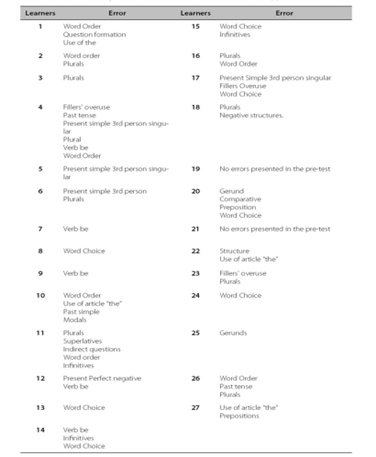
Note.Only the grammar and vocabulary errors that stopped occurring in the oral
As shown in Table 3, only 3 students (learners 1, 7 and 17) did not show any improvement in terms of pronunciation. That is, the pronunciation errors they made in the pre-test that were treated, were also perceived in the post-test.
Learners' experience when receiving CF on their oral production in English.
Krashen's (1982) Filter Hypothesis for SLA, states that there are a set of affective variables that ''interfere'' with the process of language acquisition (e.g., motivation, self-confidence and anxiety). Krashen's theory suggests that the ''language teachers should create a comfortable, lower affective filter and motivation stimulating study environments, where learners can develop higher selfesteem and greater sense of confidence and fulfillment'' (Chin, 2008, p.115). With these notions in mind, it was mandatory for this study to consider learners' feelings when receiving CF in their oral classes. There is theory out there crediting and discrediting the use of CF in language classes; however, for the purpose of the present research project, a supporting stance towards CF was taken. Generally, learners praised a learning environment where CF was provided over one where there was less interference from behalf the teacher. Since all the 40 students who answered the questionnaire agreed to a certain level on their preference when receiving CF rather than when not receiving it at all.
Figure 1 is clear displaying the way agreement levels were higher for those feelings with a ''positive'' connotation (reassurance and comfort), while for those that are perceived as ''negative'' (shame, anger and confusion) higher levels of disagreement were expressed by learners. These numbers might show a level of discrepancy with the believe some people might have, that learners do not like to be corrected, or that correcting learners' errors will only boost their anxiety, shame, anger, or any other ''negative'' feelings, thus, blocking them from using the language more freely and then, developing oral communicative skills.
How CF on oral production in English should be given.
As a second important part of the questionnaire learners were asked about the ''how's'' of CF in oral language classes. Nevertheless, besides focusing on the types of CF provided by other scholars and previously considered in this project (see Lyster & Ranta, 1997), this section of the questionnaire sought information in relation to learners' opinions and preferences regarding to whether receiving CF for every committed error or only very relevant errors, or even not receiving CF at all. Also, the questions in this section focused on information related to receiving CF individually, with individual focus but as part of the group, without any individual focus and as part of group CF. All of this aimed at drawing data about preferences language learners had regarding receiving CF only orally versus receiving it in written form plus an oral explanation of the committed errors.
Figure 2 shows how only 3 of the learners did not prefer to receive CF for every oral error they made, while the other 37 considered correcting every error in the oral language classes to have a positive impact. This notion would go against the idea that when ''students are engaged in a communicative activity, the teacher should not intervene by 'telling students that they are making mistakes' or 'insisting on accuracy''' (Harmer, 1983, as cited in Ellis 2013). However, it would, to a certain extent, agree with the theory that praises the use and results of CF in language classes. Furthermore, Figure 2 also shows how 26 of the learners either disagreed or strongly disagreed with the statement ''I prefer to receive CF only for very important oral errors I commit in English'', while 14 of them either agreed or strongly agreed with the statement. Nevertheless, considering these numbers, one might wonder which errors are important, and which are not. Also, a more complicated reality would arise because what one learner reckons important might be regarded as trivial by others. Hence, the concept or level of importance given to each of the committed errors may vary from learner to learner. Finally, in Figure 2 it is also possible to see how a massive majority of the interviewees (39 students) disagreed with the idea of not receiving CF at all. Another good theme for future research could be the analysis of the drives learners have when requested to receive any type of CF in their L2 classes.
Learning a language is a process that triggers the level of anxiety and stress in most of the individuals who undertake it. Yet made more difficult if the learner feels exposed in any sense. Therefore, if considering a public correction -one provided by the teacher in front of the rest of the class- an anxiety-triggering action, all language learners (with very few exceptions, I dare to say) will prefer to be corrected privately rather than in the presence of other students. Consequently, the numbers shown in figure 3 match these thoughts. Since 95% agreed or strongly agreed with the idea of receiving CF in private rather than in front of the rest of the group. When considering the possibility of individual, focused CF, but in the context of a class, where other learners could listen to the CF given, where CF can serve a role of exemplification and provide an instance of CF on a specific error committed by a specific learner, but from which comments the rest of the group can benefit, the number of students who agreed upon it was a little smaller.
Figure 3 shows how 65% of the interviewed students praised the idea of receiving individually focused CF in front of the class. Whereas the resting 35% of the learners did not like or discredited this type of CF. On the other hand, when asking learners about their preferences in relation to receiving CF in group and without any focus on the individual who made the error, 77% of the interviewees showed a certain level of agreement (agree or strongly agree). Nevertheless, it would be a good theme for future study to consider learners' motives to be positive towards this thought, plus the necessary conditions that a learning environment requires for providing effective CF in this fashion. Finally, when trying to identify the level of preference learners have towards receiving CF only when another learner had committed the same error they committed, Figure 3 shows how 83% of the interviewed learners disagreed with the statement, while only 17% of them agreed to a certain extent with the idea. That is, only 17% of the learners considered that an error that had not been committed by more than one student should not be corrected or addressed by the language teacher. The reasons leaners can have had for thinking like this can vary, but we can almost undoubtedly consider the unwillingness to be exposed -as they would be the only learner who made the error, and thus easily recognized by other learners- to be one of the most important motives.
A common practice, at least in my language learning experience, is that of providing mere oral CF to learners when errors are committed in oral language classes. This probably departs from the premise that the error occurred in oral text, then, only oral intervention is needed. However, as Figure 4 portrays, most of the interviewed learners showed a level of disagreement, 53% and 20% correspondingly. Opposingly, only 15% of the students agreed, and 12% of the interviewees strongly agreed with the idea of only receiving oral CF for the L2 oral errors.
Figure 4 also displays how 88% of the learners praised the use of a combined method for providing CF (written comments on a language analysis scale plus oral comments accompanying the written feedback). Even when this would render a positive notion towards this type of feedback, it would also be necessary to scrutinize the reasons for the remaining 12% of learners who discredited or disliked the provision of CF through written comments accompanied by an oral explanation.
When should CF on oral production in English be given?
Figure 5 encompasses the different timings CF could have in oral language classes and preferences learners could have towards them. Thus, 82% of the interviewed students expressed their inclination towards receiving CF right after the errors was made. Thus, benefitting a very immediate form of CF.
The second CF timing presented in Figure 5 represents a sort of intermediate type of CF, where teacher's comments or reactions about learner's errors are not provided immediately after the error is produced, but they are not delayed to after-class instances. Regarding this idea, the number of learners who en dorsed it only surpassed half of the interviewed population by 7%, which also means that 43% of the learners expressed a certain level of disagreement with the idea of receiving CF during the class, but not immediately after the error appears. Surprisingly, when compared to the two previous CF timings, Figure 5 indicates that between the learners who support immediate CF and those who prefer an asynchronous version of it there was a very slight difference. Meaning that in a group of ten students five would prefer synchronous CF, while the remaining five would tilt towards asynchronous CF.
Opposingly to Nunan (1992), who devoted more attention to positive feedback than corrective feedback (CF), as he noted that it serves two functions - ''to let students know they have performed correctly, and ''to increase motivation through praise'' (p. 195), thus, and based on his position, positive feedback would rendered more positive results than CF, the present research project was underlaid by the conception that teacher's reactions and reflections on learners' deviant forms of the TL are a crucial part of the whole language learning spectrum.
The personal teaching and learning experience of the present researcher provided a basis of thought that favored the use of CF rather than a totally CF-free environment. Hence, a stance towards the type, timing, and form of the CF to be provided to learners' spoken errors was to be taken. However, a question arose: How to provide CF that complies with or lives by comfortable, lower affective filter and motivation stimulating study environments proposed by Krashen (1982) and pondered of high relevance by this study?
Unsurprisingly, when comparing own personal teaching experiences to learners' responses to the questionnaire, students unanimously favored the use of CF in their language classes. However, this response from learners contradicts some of the theory that ponders CF as intrusive, communication-rupturing, and disliked by learners. In its second part, the questionnaire looked at the how's of CF, namely, individual versus group CF, CF on every error versus only on salient errors, and more. Regarding these aspects of CF, it was impressive to see how almost all students praised the presence of CF for all committed errors without any exceptions (92% of the students). These results suggested that CF had a positive con- notation among language learners since they considered it rendered positive outcomes.
Alongside the previous idea, only 4 of the interviewed students considered CF should be administered to only very important errors. A study on what learners reckon important could be an interesting line for future research. Towards the end of the questionnaire, in its third part, the questionnaire planned to obtain data related to the preferred timing for CF for language learners, being immediate or delayed CF. An interesting situation rose, when for the statement ''I prefer to receive CF after class'' 52% of the respondents show a level of agreement, while the remaining 48% disagree to a certain extent. Leaving us with the idea that preferences on synchronous and asynchronous CF are very polarizedeven to a 50/50 relation, when for every ten language learners five prefer immediate CF while the other five would rather have delayed CF.
CONCLUSIONS
In opposition to the close-to-zero improvement in the exams' score, when comparing the score means of the pre-test with that of the post-test, a more noticeable reduction in the errors produced by learners was found. For instance, more than 10% less errors were found in the final exam when compared to those in the first oral exam. Pronunciation was the area where errors underwent a greater decrease. Based on this, we can assume that a delayed CF method, using a combination of written feedback plus an oral explanation of these comments, can have positive results in diminishing the pronunciation errors language learners produce orally. This CF method also proved to have positive results in grammar and vocabulary errors, but to a smaller extent.
In terms of repair, it can be concluded that for errors in the category of vocabulary and grammar, the asynchronous CF method used proved beneficial for all learners. In the case of pronunciation errors, the method helps almost all learners improve their speaking skills and diminish the number of errors committed. From this study it can be concluded that students unanimously favor the use of CF in their language classes, data that matches the beliefs of the present researcher. Though this response from learners contradicts some of the theory that ponders CF as intrusive, communication-rupturing, and disliked by learners.
Furthermore, almost all students welcomed the presence of CF for all committed errors without any exceptions (92% of students). This was a little surprising for the researcher, as one might assume that learners might not like to be corrected every time they make an error, however, it is interesting to see how learners rely on teachers' work in terms of error treatment. Alongside the previous idea, only 4 of the interviewed students consider CF should be administered to only very important errors. A study on what aspects of language learners reckon important would be an interesting line for future research. In relation to the preferred timing for CF for language learners, being immediate or delayed, an interesting situation rose, learners' preferences on synchronous and asynchronous CF are very polarized -even to a 50/50 relation. An interesting line of further research could be to find out more of the reasons learners have to favor the different timing settings for CF in language classes.
To conclude, as it has been thoroughly described in this study, and depicted by the data gathered, providing asynchronous CF in virtual oral language classes has proven to be more beneficial than detrimental to language learning, more specifically in the treatment of errors related to grammar and vocabulary, and pronunciation. Hence, as every class is a different world, the language teacher needs to analyze the class environment and decide which type of CF renders more positive results and serves her/his purposes and learners' feelings and attitudes better. Also, the possibility of a mixed model of CF that combines both synchronous and asynchronous CF seems to be one of the best approaches to embark on. Just remember that CF is necessary, but it ''needs to be given in an atmosphere of support and warm solidarity'' (Ur, 1996, p. 255). It is of paramount importance to understand that the errors made when learning a language are clear evidence of the effort in learning that second language, and that SLA is a difficult process by itself.














